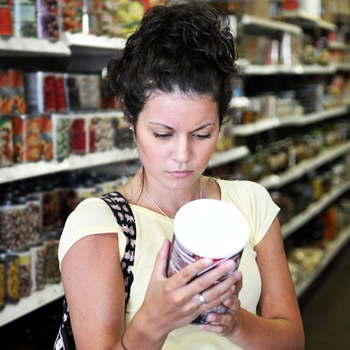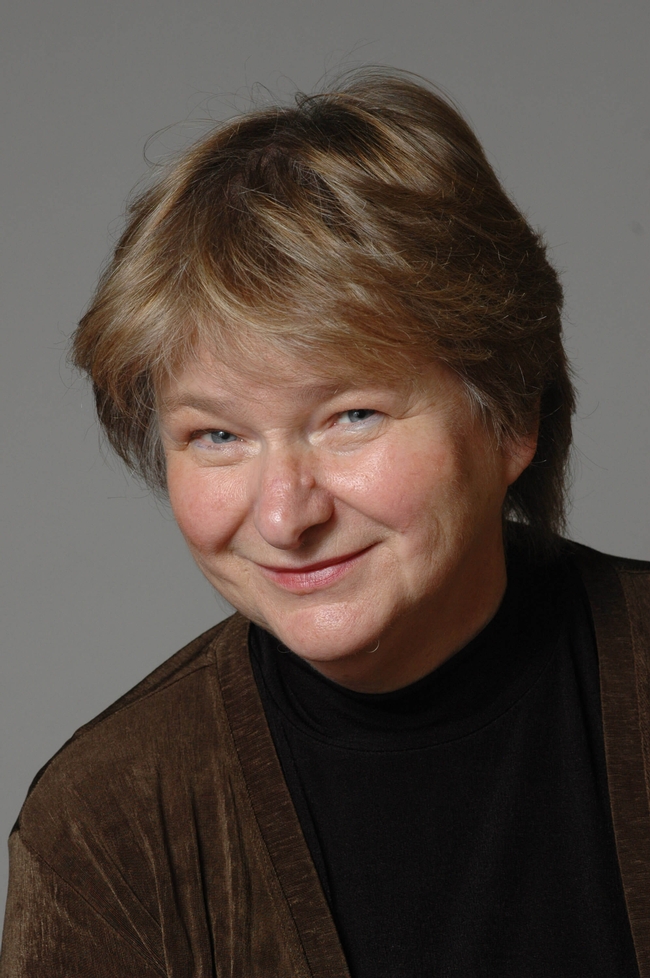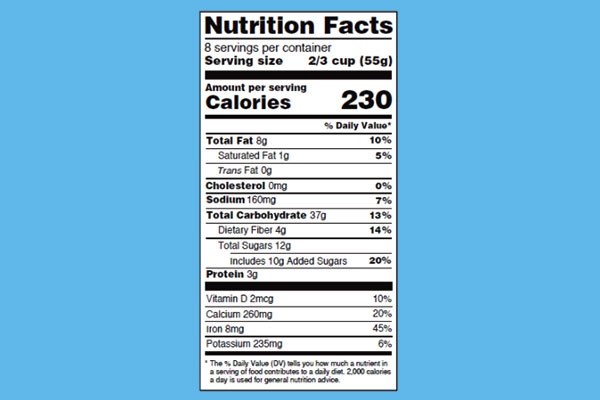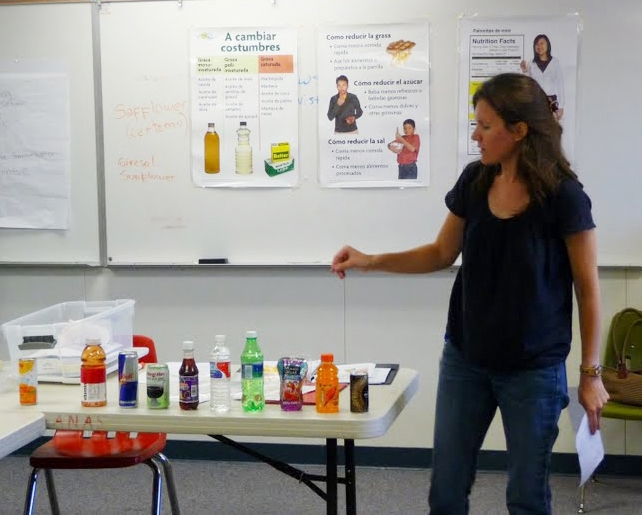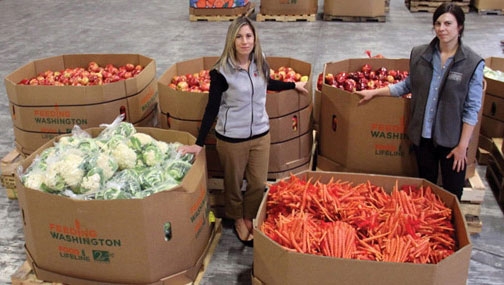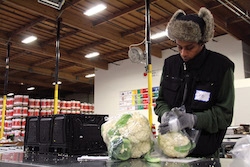Posts Tagged: Patricia Crawford
UC's Pat Crawford weighs in on childhood obesity
Today marks the start of the 9th Biennial Childhood Obesity Conference. Since it's founding 18 years ago by UC ANR Specialist Pat Crawford, it has grown from a small gathering of California researchers, educators, and health care professionals to the nation's largest gathering on the topic of pediatric obesity/overweight.
So today seems the perfect time to revisit a 2015 conversation with Rose Hayden-Smith, UC's Food Observer, and Crawford, now the Senior Director of Research at UC ANR's Nutrition Policy Institute. As Pat stated in her interview—
“Not changing is risky. The United States – along with Mexico – has the highest obesity rates in the industrialized world. With these extraordinarily high obesity rates, we are on a path toward ever-rising chronic disease rates including not just diabetes, but also heart disease and some cancers, increasing health care costs and reducing productivity.
Even more alarming, is a little known fact that 23 percent of the adolescents in this country currently have pre-diabetes or diabetes as measured by actual blood tests in our largest national study of health (NHANES). Something is seriously wrong in a society such as ours where so many children are growing up with such a high risk of preventable disease.”
You can read the complete interview at the UC Food Observer. You'll also find a recent story about the 45 youth advocates from organizations around California joining this year's conference to bring the voices of youth to this vital conversation.
As Americans struggle with obesity and diabetes, help is on the way
The iconic black-and-white Nutrition Facts label for packaged foods in the U.S. is getting its first makeover in two decades. The federal government's decision last month to update the food label means that for the first time, beginning in 2018, labels will list how much added sugar is in a product.
The decision, reflecting the latest science, will be felt well beyond the label. University of California food experts praised the labeling changes and offered six key takeaways.
1. Listing added sugar is the most important label change.
The new label will list the amount of added sugar in a product, both in grams and as a percentage of the daily recommended allowance.
“That's key,” said Laura Schmidt, a UC San Francisco professor of health policy and UC Global Food Initiative subcommittee member. “That will be really helpful for consumers.”
Added sugar – any sugar added in the preparation of foods such as table sugar, high fructose corn syrup and others – can be found in hundreds of products such as cereal, yogurt, pasta sauce and salad dressing. But the biggest source is sugar-sweetened beverages, which account for nearly half of Americans' intake of added sugar.
One 20-ounce soda will take you over the recommended amount of sugar for an entire day,” said Pat Crawford, senior director of research for the Nutrition Policy Institute of UC's Division of Agriculture and Natural Resources. “The new label will allow people to reasonably see what they're doing when they're consuming high-sugar products.”
The current label lumps added sugar with naturally occurring sugars in the foods themselves, which is a deceptive practice, said Dr. John Swartzberg, a UC Berkeley clinical professor emeritus and editorial board chair of the UC Berkeley Wellness Letter. Listing added sugar “will hopefully guide people away from consuming products with a lot of added sugar,” he said.
2. Americans need to consume less sugar.
More than one out of three adults in the U.S. is obese. Nearly half of U.S. adults have prediabetes or diabetes, raising their risk of heart attacks, kidney failure, blindness and amputations. Among U.S. children, more than 1 in 6 is obese, and diabetes and prediabetes rates are rising. Amid these alarming statistics, there's a growing concern about too much added sugar in diets.
“It's important to give the public the information they need in order to modify their diets,” Crawford said. “We are now finding significant effects on diabetes and heart disease rates for those who regularly consume sugary beverages. A large study of women over an eight-year period found that the risk of diabetes among women who consumed one or more servings of sugar-sweetened beverages per day was nearly double the risk among women who consumed less than one serving per month. Further, drinking one 12-ounce soda a day increases the risk of cardiovascular mortality by almost one-third.”
Crawford noted that the new federal dietary guidelines for the first time recommend limiting added sugars in the diet to no more than 10 percent of one's daily calories.
“The average amount of added sugar in the American diet is more than 20 teaspoons per day, nearly all of which is added to our foods during processing,” Crawford said. “Since about half of this sugar comes in the form of beverages, we have to rethink our beverage choices. Water should be the beverage of choice.”
Consumers will be very surprised to see the percentage of daily value of added sugar in one soda drink, said Michael Roberts, executive director of the UCLA Resnick Program for Food Law and Policy and UC Global Food Initiative subcommittee member. “Time will tell whether this information changes human behavior, i.e., consuming less soda. To be fair, sugar pops up everywhere, not just soda, so the impact that these changes will have on consumers and manufacturers will be interesting to watch.”
3. Expect manufacturers to make product changes.
When the federal government required that manufacturers add trans fat information on the label a decade ago, the food industry responded by marketing more products with lower trans fats, Crawford said.
“Trans fats are now not allowed to be added to foods during processing, but it all began with labeling,” Crawford said. “We're going to see some big shifts in the marketplace with products lower in sugars such as cereals, yogurts, spaghetti sauces and beverages, of course. We can look forward to recipe reformulation, which will make products more competitive. It's a great first step for reducing sugar consumption. In preparation for the new labels, manufacturers are working on creating products with lower levels of added sugars.”
For manufacturers, the trick will be to keep food tasting good to consumers while reducing sugar, Roberts said. “Other large manufacturers will pursue new products that are not heavy on added sugars,” Roberts said. “For example, Coke and Pepsi sell bottled water.”
“There is a push to at least re-size products,” Schmidt added. “There certainly will be an effort for front-of-package labeling that says ‘low sugar.'”
4. The new label could lead to regulations limiting sugar.
“Including added sugar on the label will be a game-changer for those debates about what is a healthy diet for people in the federal food-assistance programs,” said Schmidt, lead investigator on the UCSF-led SugarScience research and education initiative. “Once you've got added sugar on the label along with a daily reference value, policymakers will be in the position to set standards for the quantity of added sugar allowed in school lunches and other federal food programs.”
Changes like this have happened before, Schmidt noted. “In the U.K., the government said salt consumption is way too high and mandated that packaged food manufacturers reduce the amount of sodium in their products. It worked like a charm – they just gradually reduced the excess salt in foods to everyone's benefit.”
5. The new label makes changes beyond sugar.
The new label also will list more realistic serving sizes and will list calories in a larger and bolder font. “This will help people assess how many calories they are actually consuming,” Swartzberg said. (View a complete list of label changes here.)
6. Further steps could help consumers.
While praising the label changes, UC experts say further steps could help consumers make more informed choices:
- Adding front-of-package labeling that states whether the product is high in sugar, salt or fat: “This banner on the front of packages would make it simple for a consumer to see whether a food is healthy or whether it has ingredients that contribute to risk of heart disease, stroke, obesity or cancer,” Crawford said.
- Having food vendors add “stoplight” stickers: “There is the stoplight idea of labeling products with green, yellow and red stickers – green for the low-sugar products and red for the high-sugar ones,” offered Schmidt.
- Promoting environmentally sustainable food practices: “(We should) consume more plant-based foods and less meat,” Swartzberg suggested.
- Increasing research: “The label change is not enough: Further research, education and sound policies will need to be developed to motivate more healthy eating,” Roberts said.
Experts combine research with policy to reduce childhood obesity
It was the first time a UC president has taken part in the long-running and nationally recognized gathering, noted the director of UC Agriculture and Natural Resources' Nutrition Policy Institute (NPI), Lorrene Ritchie.
“I think it demonstrates her commitment to the Global Food Initiative and the work we do at UC ANR,” Ritchie said.
During her remarks, Napolitano said it was fitting for her to speak at the conference as it coincided with the one-year anniversary of the Global Food Initiative, a sweeping effort involving all UC campuses and UC ANR that was inspired by many of the same concerns addressed by conference participants.
“As we meet here in San Diego today, a billion people — most but not all of them in the developing world — suffer from chronic hunger or serious micronutrient deficiencies,” Napolitano said. “Another half billion — primarily in the industrialized nations of the world, like the United States — suffer from obesity.”
Since the biennial conference's inception, Patricia Crawford, UC ANR Cooperative Extension nutrition specialist, and other members of NPI have been involved in its planning. Crawford announced she is “passing the baton” to Ritchie to guide the conference moving forward.
More than 1,700 nutritionists and other experts on children's health attended the San Diego gathering June 29 – July 2. In addition to the NPI, the conference was hosted by the California Department of Public Health, California Department of Education, the California Endowment and Kaiser Permanente.
NPI hosted a preconference workshop on June 29 to bridge the gap between research and policy regarding the federal nutrition assistance programs and the Dietary Guidelines, which reach more Americans than any other nutrition policy.
“The preconference session provided a rare opportunity for policymakers and administrators, nutrition researchers, advocates, and funders to sit together to identify today's key policy issues and propose research to inform future policy debates and developments,” said Kenneth Hecht, NPI director of policy. “Participants also focused on another extremely important question: How to improve communications in both directions between researchers and policymakers.”
At the opening plenary session, Chelsea Clinton, vice-chair of The Clinton Foundation, talked about projects her family's foundation work to improve children's health and literacy.
“Childhood obesity is a national security challenge. The Joint Chiefs of Staff said that very clearly in 2013,” Clinton said. “In New York City, where I live, the New York City Fire Department and Police Department have said they are worried they won't be able recruit enough people to fill their ranks if obesity rates continue.”
To help address the problem, the Clinton Foundation along with the American Heart Association established the Alliance for a Healthier Generation 10 years ago. Because of the program, nearly 300 California schools have made changes significantly reducing overweight among children.
“Grateful to all @ObesityConffor for a great morning talking about @HealthierGenand for everything you do to help children be healthy!#COC15,” Clinton tweeted after her presentation.
During a workshop session, NPI's Ritchie and other panelists discussed the importance of policies and standards for healthy alternatives to sugar-sweetened beverages for children in childcare settings. Crawford and other panelists presented data on childhood obesity trends and racial/ethnic disparities in California and discussed the health and financial consequences. They also addressed the cost-effectiveness of national and state excise taxes on sugar-sweetened beverages and labels to inform consumers of the health risks of consuming sugary drinks.
Hecht also moderated a panel on local and national initiatives that are linking farm fresh produce to food bank recipients. NPI researcher Elizabeth Campbell, who participated in the discussion with a local farmer, a food bank employee and a public health anti-hunger advocate, said food banks should have policies to guide the nutritional quality of their inventory.
During the closing plenary, First Lady Michelle Obama sent video greetings to the Childhood Obesity Conference attendees to praise them for their work and encourage them to continue to fight to protect children's health.
PowerPoint presentations from the conference are available online. Photos and postconference information can be seen on Facebook and Twitter and with the hashtag #COC15.
Sugary drinks are hiding under a 'health halo'
Researchers investigated the growing and often confusing list of supplements added to the drinks. In most cases, they found, the beverages provide little or no health benefits, and might be dangerous.
"Despite the positive connotation surrounding energy and sports drinks, these products are essentially sodas without the carbonation," said Patricia Crawford, UC Cooperative Extension specialist in the Department of Nutritional Sciences and Toxicology at UC Berkeley.
The study looked at 21 popular drinks touted by manufacturers as "health and performance enhancing." In addition to sugar, caffeine, non-caloric sweeteners, sodium, vitamins and minerals, some drinks included the supplements guarana, ginseng, taurine, gingko biloba and ginger extract. Of the five herbal supplements, only ginger extract is classified as "likely safe" for children, Crawford said.
Because they contain caffeine, marketers promote the beverages as improving energy, concentration, endurance and performance. The study, however, documented harmful effects, such as increasing stress, nervousness, anxiety, headaches, insomnia, tremors, hallucinations and seizures.
"(Drink manufacturers') health marketing claims are the 21st Century equivalent of selling snake oil," said Harold Goldstein of the California Center for Public Health Advocacy, which commissioned the study.
The full report is at http://www.publichealthadvocacy.org/healthhalo.html.
Banking on nutrition
It's a drizzly winter morning, and dozens of volunteers at the San Francisco–Marin Food Bank are slowly breaking down a 2,000-pound sack of whole oats into 1-pound bags, their hair tucked back in neat plastic caps. A decade ago, volunteers were more likely to be boxing up canned foods items. Today, 60 percent of everything ferried out of this warehouse is fresh produce. No soda or chips are in sight, and whole grains like these General Mills oats are standard.
For food banks nationwide to move in a similar healthy direction, coordinated efforts must increase at all levels. It will take leadership like that provided by Feeding America, the national food bank network organization; expanded support for nutrition policies at the local and regional levels; and donor efforts to supply more healthful foods. It's a tall order. But with the growing ranks of the food-insecure and obese, there is more pressure — and desire — than ever to provide low-income families with healthful food and create support for food bank nutrition policies to ensure that happens, says Patricia Crawford, UC Cooperative Extension specialist and director of UC Berkeley's Atkins Center for Weight and Health (CWH), a partnership between the College of Natural Resources and the School of Public Health.
“People managing food banks are taking charge and doing the difficult thing of modifying the healthfulness of the food donations they solicit,” says Karen Webb, a nutritional epidemiologist at CWH. “On the one hand, the food banks want an ample supply of foods to hand out, but they're also advocates for people in our most vulnerable population, so the nutritional quality of that food is important.”
There has been progress, which CWH researchers and their colleagues, at the request of the Institute of Medicine (IOM), the health arm of the National Academy of Sciences, have documented in ‘A Movement Toward Nutrition-Focused Food Banking,' an upcoming discussion paper to be released in summer 2014. The report details the evolution of food banking as the number of people served by these organizations jumped a whopping 46 percent from 2006 to 2010, according to Feeding America. Today, 12 percent of the population uses the emergency food system. Driven by increased demand, food banks have shifted from an emergency lifeline to a service filling a chronic need.
While organizations move to provide more healthful food, it's clear that pantry users, or clients, want these foods. A 2011 CWH study asked clients to rank calorie-dense snack-type foods and beverages as well as healthy options by order of preference.
“Food pantry clients ranked the most nutritious foods highest,” says Webb, a co-author of the IOM report. “Those foods are expensive, and they want to receive them. Meat, dairy, and fresh produce are at the top of their list, while soda and candy rank lowest.”
What policy looks like
Getting healthier food into clients' hands requires changes in both policy and practice, but what exactly is a nutrition-driven food policy? Many stakeholders are trying to effect change — food banks and the umbrella groups that support them, organizations and corporations that donate, and state and federal governments — but there are few cohesive policies and common standards to govern how they work together.
To start with, food banks can benefit from formal written guidelines that address the nutritional quality of the foods and beverages that they purchase or acquire from donations, according to the recommendations in the IOM report, whose authors include CWH's Elizabeth Campbell and Michelle Ross, Heather Hudson of the Food Bank of Central New York, and Ken Hecht, formerly with California Food Policy Advocates. A policy should guide the nutritional quality of the food bank's inventory as well as provide data analysis to track how successful the food bank is at distributing foods like produce and limiting unhealthful ones such as processed crackers and chips. Some 56 out of 200 food banks have a policy in place, according to a recent Feeding America survey, but more must be done.
Alameda County Community Food Bank (ACCFB) is a policy model, Crawford says. It established a written policy in June 2013, with the help of the nonprofit anti-hunger group MAZON and CWH. The project, which included several other food banks, was funded by Kaiser Permanente.
“We held focus groups with staff members and agency representatives,” says Jenny Lowe, ACCFB's nutrition education manager. “We wanted to get everyone on the same page. We asked, what are our practices? We'd been following this for a long time, but never wrote it down.”
The food bank's policy is now clear. They purchase fresh fruits and vegetables, low-sugar canned fruits, low-salt canned vegetables, low-fat milk, lean proteins, nut butters, beans, whole grains, packaged meals and soup.
To track the healthfulness of food, they use a computer system that ranks inventory by nutritional level (1, 2, or 3) and employ “traffic light” labeling on the warehouse floor and on order forms. Green is “choose frequently,” yellow “moderately,” and red “sparingly.”
“Green” foods are now more readily available at food banks across California because of the California Association of Food Banks' (CAFB) Farm to Family program, which connects state growers and packers to food banks. In 2011, CAFB, a nonprofit, membership-based umbrella group, sponsored AB152, now a state law, which enables farmers to get a 10 percent tax break on the inventory costs of fruits and vegetables they donate.
CAFB exemplifies how agriculture, advocates, and food banks can work together to create policies that incentivize the support system for healthy diets. Since 2005, the group has increased food bank produce donations by 92 million pounds of fruits and vegetables that might have otherwise been plowed under in the fields. “In California, we have a progressive agricultural community as well as progressive food bank organizers,” Crawford says. “It's that convergence that has made California a model and brought national attention to what we're doing.”
Other positive steps: Feeding America appointed a director of nutrition in 2011, and in 2012, it implemented Foods to Encourage, nutrition guidelines for promoting health—the food bank network's first-time effort at national guidelines. It's also running a pilot program that connects food-insecure clients who have Type 2 diabetes with nutrition, health education, and medical care.
Even with successes like these, there's still a long way to go.
Fresh food, new challenges
Six California food banks participated in a 2010–11 CWH study on inventory trends, funded by the Robert Woods Johnson Foundation. All six had significantly increased the amount of produce they provide to pantries, the study found, but hardy onions and potatoes made up about half of those gains. While the increase in fresh produce was dramatic, getting a variety of vitamins and minerals from different types of produce is key to good nutrition, Webb says.
“Food banks now must tackle the next challenge: adding more colorful yet hardy vegetables, such as bell peppers and broccoli," Webb said.
Part of that challenge is providing better distribution systems to pantries. Many food banks boast state-of-the-art facilities with refrigerated trucks and big walk-in refrigerators, but the pantries they serve are often basement kitchens and church halls with little access to refrigeration or storage. Policy changes must consider how to improve these conditions. For example, ACCFB provides farmers-market style distribution in parking lots to some clients, and both ACCFB and the state of New York help provide pantries with equipment grants to improve facilities.
Sourcing is another hurdle. Although emergency food clients strongly prefer low-fat dairy, lean proteins, and whole grains over soda and other less nutritious foods, it can be difficult for food banks to procure donations that align with these preferences and with nutritional quality guidelines. In 2013, 66 percent of donated foods came from big companies and represented the largest source for food banks, according to Feeding America. Donations of sugary beverages and snack foods have declined substantially, but have not disappeared from the shelves of the six California food banks in the CWH study. In 2010, one California food bank alone distributed over a million pounds—208 million calories—of what Crawford calls “liquid sugar” drinks. “That's a heck of a lot of excess calories going out to the most vulnerable people, who have a greater likelihood to be diabetic and overweight than higher-income folks,” Webb says.
Crawford notes that both the Central New York and Alameda County food banks have successfully implemented nutrition policies without offending donors or losing support.
Moving nutrition forward
In February 2012, anti-hunger leaders convened in Oakland, Calif., to discuss their findings from the 2010–11 Robert Wood Johnson Foundation study. There, CWH and California Food Policy Advocates called for food bank procurement policies that meet or exceed the Foods to Encourage guidelines, which were due to be released later that year.
In the most recent nudge forward, the IOM report recommends that items available through U.S. Department of Agriculture food distribution programs align with key recommendations from the 2010 Dietary Guidelines for Americans. Most food that the USDA supplies to food banks is already healthy, a recent study showed, and the agency is moving quickly to further improve nutritional quality by adding items like whole-grain pastas and brown rice. The report also recommends that food banks and advocates work with donors to find new ways to incentivize nutritious donations.
The IOM report represents a formidable increase in visibility for the issue of food bank nutrition, and Crawford wants to take advantage of the momentum. She's calling for a meeting of key stakeholders to discuss how to keep improvements to the emergency food system's nutritional quality moving forward.
Obesity and diabetes risk continue to plague the nation's health, and food banks will face big challenges in the coming year, including an expected rise in the number of clients as a result of the recent $8.6 billion in cuts to the Supplemental Nutrition Assistance Program — or SNAP, formerly known as food stamps — part of the farm bill passed in February, and as a consequence of California's drought, which is expected to bump up food prices.
“Those of us working in the field of hunger and food insecurity want the best for the people we serve,” Crawford says. “There is a moral imperative to do more than to provide just calories. We must provide foods that will help protect the health of the most vulnerable in our society.”
This article originally appeared in the spring 2014 issue of Breakthroughs, the magazine of the UC Berkeley College of Natural Resources.



